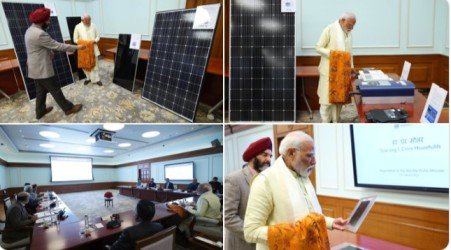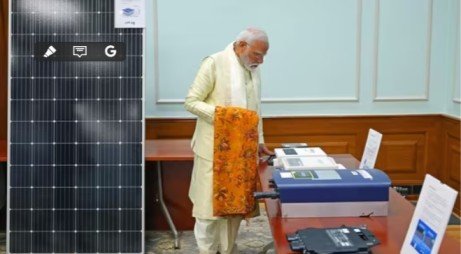India, under the leadership of Prime Minister Narendra Modi, is taking a giant leap towards a sustainable and self-reliant energy future with the introduction of the ‘Pradhan Mantri Suryodaya Yojana.’ This visionary scheme, announced on the auspicious occasion of consecration in Ayodhya, aims to provide rooftop solar panels to one crore households across the nation. Let’s delve into the details of this initiative and its potential impact on the country’s energy landscape.

The Inspiration Behind Pradhan Mantri Suryodaya Yojana:
Prime Minister Modi, drawing inspiration from the divine energy of Suryavanshi Lord Shri Ram, expressed his resolution that every household in India should have its own solar rooftop system. This resolution was strengthened during the consecration ceremony in Ayodhya, leading to the unveiling of the ‘Pradhan Mantri Suryodaya Yojana.’
Implementation and Government Initiatives:
The swift decision to launch the scheme came hours after Prime Minister Modi’s return from Ayodhya. PM participated in the consecration ceremony of Lord Ram Lalla in the newly built Ram Janmabhoomi temple. The government is committed to the successful implementation of the Pradhan Mantri Suryodaya Yojana.
- National Campaign for Rooftop Solar AdoptionPM Modi has urged officials to initiate a massive national campaign to mobilize residential consumers to adopt rooftop solar on a large scale. This campaign is crucial for creating awareness and encouraging widespread adoption of solar energy.
- Financial Assistance Through National Rooftop SchemeThe Centre has established the National Rooftop Scheme, offering financial assistance amounting to 40% of the capital cost of a solar rooftop project. This financial support plays a vital role in making solar energy accessible to a broader segment of the population.

Source: ANI
Guide to Understanding Rooftop Solar Panels:
Rooftop solar panels are photovoltaic panels installed on the roofs of buildings, connected to the main power supply unit. This technology reduces the consumption of grid-connected electricity, resulting in cost savings for consumers. In a solar rooftop system, there is only an upfront capital investment and minimal maintenance costs, making it an economically viable and environmentally friendly choice.
Understanding the Watt as a Unit of Power; Before we delve deeper into the success stories of solar initiatives, let’s understand the unit of power – the watt. In the context of solar energy, a watt measures the amount of energy used over time, specifically one Joule per second. This unit becomes essential in assessing the capacity and efficiency of rooftop solar systems.
Economic Efficiency of Rooftop Solar Systems:
One of the standout features of rooftop solar systems is the upfront capital investment. Unlike traditional energy sources that demand continuous financial commitment, installing solar panels on your rooftop involves a one-time investment. This simplicity makes the transition to solar energy financially accessible for both individuals and businesses.
Moreover, the maintenance costs associated with rooftop solar systems are impressively low. Once the solar panels are in place, they require minimal attention – periodic cleaning and routine checks are all that’s needed. This ease of maintenance translates to long-term savings, making rooftop solar a financially attractive option.
To further sweeten the deal, the Indian government has introduced the National Rooftop Scheme, offering financial assistance amounting to 40% of the capital cost of a solar rooftop project. This initiative not only alleviates the financial burden on users but also encourages a broader adoption of sustainable energy practices.
Government Initiatives and Achievements:
India has been making significant strides in its journey towards cleaner and sustainable energy. As of December 2023, the country boasts a solar power installed capacity of 73.31 GW, showcasing a robust commitment to renewable energy. What’s particularly noteworthy is the rooftop solar installed capacity, standing at 11.08 GW. This indicates a growing awareness and acceptance of rooftop solar systems among the Indian populace.
Back in 2014, the union government kickstarted the Rooftop Solar Programme with a visionary goal – achieving a cumulative installed capacity of 40,000 MW (or 40 GW) by 2022. This ambitious program aimed to accelerate the adoption of solar energy on rooftops across the nation, paving the way for a greener and more sustainable future.
Key Purpose of Pradhan Mantri Suryodaya Yojana
The main goal of the Pradhan Mantri Suryodaya Yojana is to install rooftop solar panels on one crore houses. By doing so, the government aims to achieve two significant outcomes:
Benefits for the People:
The Pradhan Mantri Suryodaya Yojana brings tangible advantages for the people of India
- Reduced Electricity Bills: Installing solar panels on rooftops will help cut down electricity bills, especially for the poor and middle-class families. Families can save money and allocate those funds to other essential needs, ultimately improving their quality of life.. This is a positive step towards easing the financial burden on households.
- Self-Reliance in Energy: The initiative aligns with the broader vision of making India self-reliant in the field of energy. By harnessing solar power at the individual household level, the nation takes a leap towards sustainability and independence in energy production.
- Empowering One Crore HouseholdsThe primary aim of the scheme is to equip one crore households, ranging from the poor to the middle class, with rooftop solar panels. This initiative is designed to democratize access to clean and renewable energy.
- Environmentally Friendly: Solar power is clean and renewable, contributing to a greener environment. By embracing solar energy, households become part of the larger movement towards sustainable living.
- Empowering Rural Areas: The scheme is expected to reach households in both urban and rural areas, promoting equitable access to clean energy and fostering development in all regions.
- Infrastructure Development Opportunities: The success of the initiative hinges on robust infrastructure to support the installation and maintenance of rooftop solar panels. This opens up significant opportunities for companies involved in developing the necessary infrastructure. From efficient distribution networks to advanced storage solutions, the demand for infrastructure development is set to rise, presenting a landscape ripe for investment.
PM Suryodaya Yojana Eligibility Criteria:
To ensure the targeted impact of the PM Suryodaya Yojana, specific eligibility criteria have been established. Those who meet the following requirements are eligible to benefit from this transformative solar power initiative.
Residential Status:
To be a part of the PM Suryodaya Yojana, applicants must be residents of India. This criterion ensures that the benefits of the scheme reach those living in the heart of rural communities, where access to conventional power sources might be limited.
Income Criteria:
In the spirit of aiding the needy, the scheme incorporates specific income criteria. This ensures that the assistance is directed towards those who genuinely require support, making the impact of the initiative more profound and meaningful.
Property Ownership:
Owning the property where the solar panels are to be installed is often a key criterion. This ensures that the beneficiaries have a stake in the project, fostering a sense of ownership and responsibility towards the maintenance and optimal usage of the solar power systems.
Previous Beneficiaries:
Priority is often given to individuals who have not benefited from similar government solar energy schemes in the past. This approach broadens the reach of the initiative, aiming to touch the lives of those who haven’t experienced the advantages of solar power before.
Government Service Association:
Applicants should not be associated with any government service. This criterion is in place to target individuals who may not have access to similar schemes through their employment.
Who Will Get the Benefit of Pradhan Mantri Suryodaya Yojana ?
The PM Suryodaya Yojana is designed to cater to the needs of rural individuals and households facing energy challenges. Specifically, the scheme aims to benefit:
Low-Income Families:
The income criteria ensure that those with limited financial resources receive priority, bringing sustainable energy solutions to economically vulnerable households.
Non-Government Employees:
By excluding those associated with government services, the scheme focuses on individuals who may not have alternative avenues for accessing solar energy benefits.
Permanent Residents of India:
The residency requirement ensures that the benefits are directed towards those living in the heart of rural communities, where conventional power sources may be limited.
First-Time Beneficiaries:
Preference is given to individuals who have not previously benefited from similar government solar energy schemes. This expands the reach of the initiative to those who haven’t had the opportunity to experience the advantages of solar power before.
In essence, the PM Suryodaya Yojana is tailored to uplift the lives of those who meet the specified eligibility criteria, ensuring that solar power becomes a reality for households that need it the most.
PM Suryodaya Yojana Application Process:
Online Application
The application process for PM Suryodaya Yojana is streamlined and accessible through a dedicated online portal. This user-friendly approach facilitates easy participation, ensuring that even those with limited technological exposure can apply effortlessly.
Documentation
Applicants need to submit essential documents such as identity proof,
address proof,
income certificates,
applicant’s aadhar card
Domicile Certificate.
electricity bill,
mobile number,
bank passbook,
passport size photo,
Ration card
bank passbook of the applicant. Some of this documentation may be crucial for the verification process, ensuring that the benefits reach the deserving candidates.
Verification
After the submission of applications, a meticulous verification process takes place. This step is vital to maintain the integrity of the scheme and guarantee that the assistance is directed towards genuine cases, aligning with the scheme’s objectives.
Approval and Installation
Upon successful verification, the applicants receive approval, marking the commencement of the installation process. The solar power systems are strategically placed at designated locations, bringing light to areas that were once shrouded in darkness.
Scheme Launch Date
The announcement of PM Suryodaya Yojana was a momentous occasion, made by Prime Minister Modi during the Ayodhya Ram Mandir event. However, as of the latest information available, no specific start date for the scheme has been provided. It is crucial for interested individuals to stay updated with official government announcements to learn about the exact commencement date.
